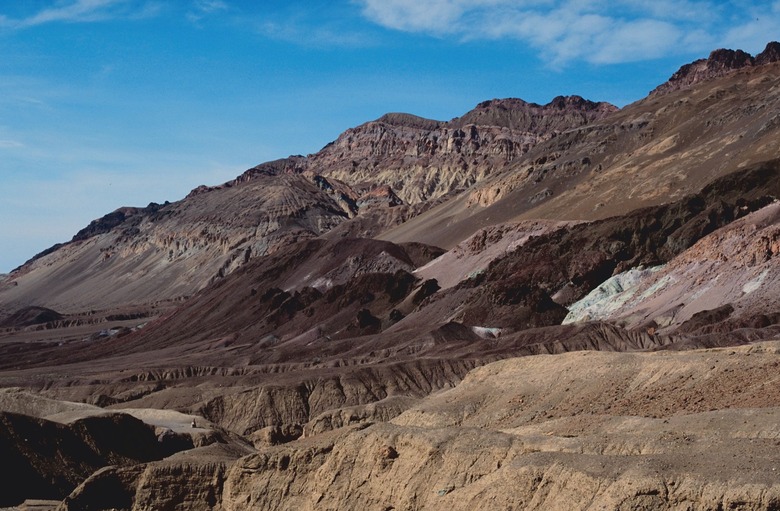What Happens When Air Goes Down The Leeward Side?
The way that mountains shape climate is known as the orographic effect, which describes how air masses change as they ascend and descend the sides of mountains. The leeward side of a mountain is often associated with warm, dry air. Rain shadows are created on the leeward slopes of mountain ranges, resulting in deserts or other climates characterized by low precipitation. This impacts the condensation water cycle step and the precipitation water cycle step as well.
Temperature and Humidity
Temperature and Humidity
To understand what happens to leeward slope air, it is necessary to get a sense of what happens to air when it cools and warms. Relative humidity (RH) measures the amount of water vapor, or moisture, in the air in relation to how much moisture the air could hold at a given temperature. Thus, an RH of 40 percent means that the air contains 40 percent of the moisture that it could hold at its current temperature.
When the RH reaches 100 percent, the air is said to have reached its saturation, or dew, point, and condensation will happen in the form of dew, fog, rain or other precipitation. Because cool air cannot hold as much moisture as warm air, the dew point is reached more quickly when warm air cools.
Windward and Leeward
Windward and Leeward
Mountains have two sides: windward and leeward. The windward side faces the wind and typically receives warm, moist air, often from an ocean. As wind hits a mountain, it is forced upward and begins to cool. Cool air reaches its dew point more quickly, and the result is rain and snow.
As the air crests the mountain and goes down the leeward slope, however, it has lost much of its moisture on the windward side. The leeward side air also warms as it descends, lowering humidity even more. An example of this effect is Death Valley National Monument in California. Death Valley is located on the leeward side of the Sierra Nevada mountains, and it is one of the driest and warmest places on Earth.
Chinook Winds
Chinook Winds
The orographic effect creates cooler air moving up the windward side of mountains and warmer air moving down the leeward side. Often, as the leeward air plunges down the slope, it warms quite dramatically and rapidly. Such rapid warming and drying of air can produce very high winds known as Chinook or Foehn winds.
They occur when mountain ranges are at right angles to prevailing winds, such as in the Sierra Nevadas of North America or the Alps in Europe. The leeward slope winds can raise temperature as much as 1 degree Celsius for every 100-meter drop in elevation (5.5 degrees Fahrenheit per 1,000 feet). In Canada, the Chinook, or "snow eater" winter winds bring quickly rising temperatures that rapidly melt snow.
Rain Shadows
Rain Shadows
Another aspect of the orographic effect is the creation of rain shadows on the leeward side of mountains. Rain shadows are more prevalent when the windward side of a mountain is steep, and thus warm air cools more rapidly over a shorter distance creating more windward-side precipitation. Thus, the leeward-side air is even drier since the saturated air lost its moisture more quickly on the windward side.
An example of this effect is seen in the Appalachians of the eastern United States. Moist air cools at a normal lapse rate of 6 degrees Celsius for every 1,000-meter rise in elevation (3 degrees Fahrenheit per 1,000 feet). In the Appalachians, however, the moist lapse rate is 40 percent greater, and thus the western, or leeward, side of the mountains receives much less precipitation.
References
- University of Wyoming Resources in Atmospheric Sciences: Precipitation and Orography
- Scientific American: What Causes Humidity?
- University of Arizona Master Watershed Steward: Elevation Drives Patterns in Precipitation
- National Park Service: Death Valley Weather and Climate
- Weather Online: Föhn (Foehn) Wind
- Virginia Places: Rain Shadows — The Orographic Effect
Cite This Article
MLA
Peterson, John. "What Happens When Air Goes Down The Leeward Side?" sciencing.com, https://www.sciencing.com/happens-air-goes-down-leeward-side-12306583/. 19 June 2019.
APA
Peterson, John. (2019, June 19). What Happens When Air Goes Down The Leeward Side?. sciencing.com. Retrieved from https://www.sciencing.com/happens-air-goes-down-leeward-side-12306583/
Chicago
Peterson, John. What Happens When Air Goes Down The Leeward Side? last modified March 24, 2022. https://www.sciencing.com/happens-air-goes-down-leeward-side-12306583/
